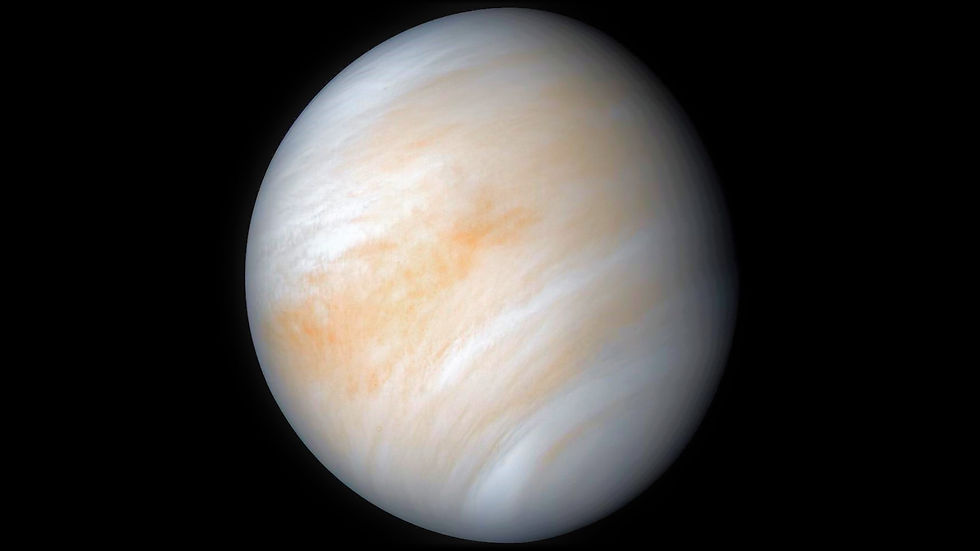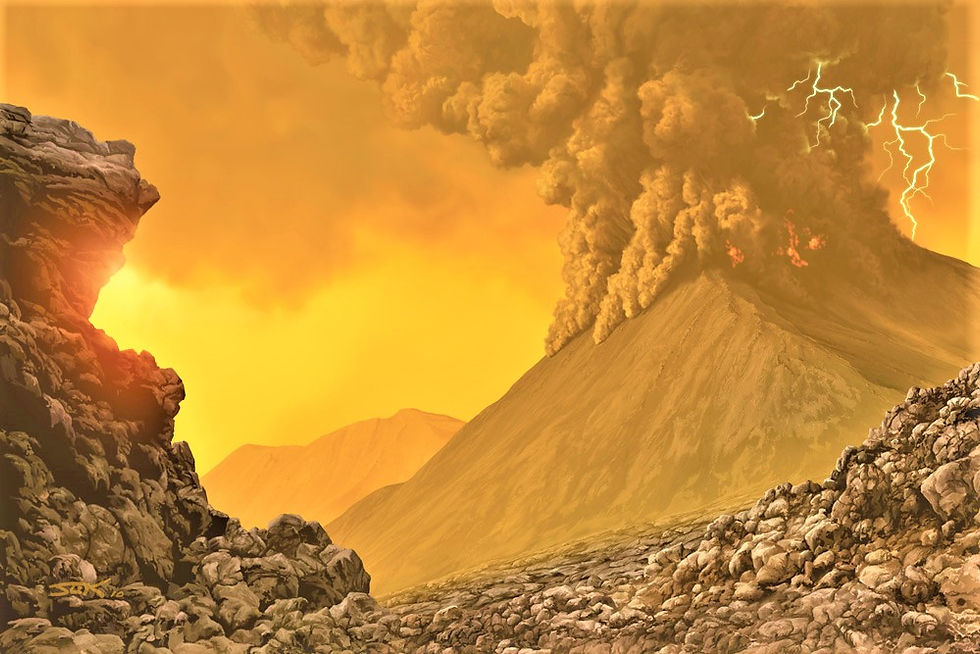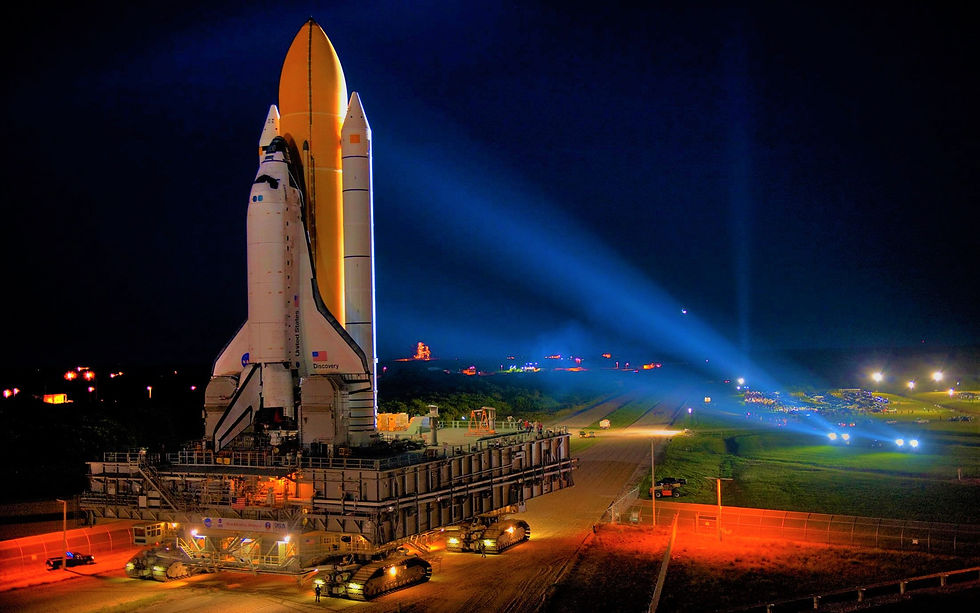Venus
- pilot55kassas55
- 8 أغسطس 2022
- 6 دقيقة قراءة
Venus is the second planet from the Sun and is named after the Roman goddess of love and beauty. As the brightest natural object in Earth's night sky after the Moon, Venus can cast shadows and can be visible to the naked eye in broad daylight. Venus's orbit is smaller than that of Earth, but its maximal elongation is 47° thus, at latitudes with a day-night cycle, it is most readily visible for up to a few hours following the start of sunset or before sunrise. At times, it has been seen in a completely dark sky. Venus orbits the Sun every 224.7 Earth days.
It has a synodic day length of 117 Earth days and a sidereal rotation period of 243 Earth days. Consequently, it takes longer to rotate about its axis than any other planet in the Solar System, and does so in the opposite direction to all but Uranus. This means that the Sun rises from its western horizon and sets in its east. Venus does not have any moons, a distinction it shares only with Mercury among the planets in the Solar System.
Atmosphere and climate
Venus has an extremely dense atmosphere composed of 96.5% carbon dioxide, 3.5% nitrogen—both exist as supercritical fluids at the planet's surface—and traces of other gases including sulfur dioxide. The mass of its atmosphere is 92 times that of Earth's, whereas the pressure at its surface is about 93 times that at Earth's—a pressure equivalent to that at a depth of nearly 1 km (5⁄8 mi) under Earth's oceans. The density at the surface is 65 kg/m3 (4.1 lb/cu ft), 6.5% that of water or 50 times as dense as Earth's atmosphere at 293 K (20 °C; 68 °F) at sea level. The CO2-rich atmosphere generates the strongest greenhouse effect in the Solar System, creating surface temperatures of at least 735 K (462 °C; 864 °F).
This makes the Venusian surface hotter than Mercury's, which has a minimum surface temperature of 53 K (−220 °C; −364 °F) and maximum surface temperature of 700 K (427 °C; 801 °F), even though Venus is nearly twice Mercury's distance from the Sun and thus receives only 25% of Mercury's solar irradiance. Because of its runaway greenhouse effect, Venus has been identified by scientists such as Carl Sagan as a warning and research object linked to climate change on Earth.
Venus's atmosphere is extremely rich in primordial noble gases compared to that of Earth. This enrichment indicates an early divergence from Earth in evolution. An unusually large comet impact or accretion of a more massive primary atmosphere from solar nebula have been proposed to explain the enrichment. However, the atmosphere is also depleted of radiogenic argon, a proxy to mantle degassing, suggesting an early shutdown of major magmatism.
Studies have suggested that billions of years ago, Venus's atmosphere could have been much more like the one surrounding the early Earth, and that there may have been substantial quantities of liquid water on the surface. After a period of 600 million to several billion years, solar forcing from rising luminosity of the Sun caused the evaporation of the original water. A runaway greenhouse effect was created once a critical level of greenhouse gases (including water) was added to its atmosphere. Although the surface conditions on Venus are no longer hospitable to any Earth-like life that may have formed before this event, there is speculation on the possibility that life exists in the upper cloud layers of Venus, 50 km (30 mi) up from the surface, where the temperature ranges between 303 and 353 K (30 and 80 °C; 86 and 176 °F) but the environment is acidic. The putative detection of an absorption line of phosphine in Venus's atmosphere, with no known pathway for abiotic production, led to speculation in September 2020 that there could be extant life currently present in the atmosphere. Later research attributed the spectroscopic signal that was interpreted as phosphine to sulfur dioxide, or found that in fact there was no absorption line.
Thermal inertia and the transfer of heat by winds in the lower atmosphere mean that the temperature of Venus's surface does not vary significantly between the planet's two hemispheres, those facing and not facing the Sun, despite Venus's extremely slow rotation. Winds at the surface are slow, moving at a few kilometres per hour, but because of the high density of the atmosphere at the surface, they exert a significant amount of force against obstructions, and transport dust and small stones across the surface. This alone would make it difficult for a human to walk through, even without the heat, pressure, and lack of oxygen.

Volcanism
Much of the Venusian surface appears to have been shaped by volcanic activity. Venus has several times as many volcanoes as Earth, and it has 167 large volcanoes that are over 100 km (60 mi) across. The only volcanic complex of this size on Earth is the Big Island of Hawaii. 154 This is not because Venus is more volcanically active than Earth, but because its crust is older and is not subject to the same erosion process. Earth's oceanic crust is continually recycled by subduction at the boundaries of tectonic plates, and has an average age of about a hundred million years, whereas the Venusian surface is estimated to be 300–600 million years old.
Several lines of evidence point to ongoing volcanic activity on Venus. Sulfur dioxide concentrations in the atmosphere dropped by a factor of 10 between 1978 and 1986, jumped in 2006, and again declined 10-fold. This may mean that levels had been boosted several times by large volcanic eruptions. It has also been suggested that Venusian lightning (discussed below) could originate from volcanic activity (i.e. volcanic lightning). In January 2020, astronomers reported evidence that suggests that Venus is currently volcanically active, specifically the detection of olivine, a volcanic product that would weather quickly on the planet's surface.
In 2008 and 2009, the first direct evidence for ongoing volcanism was observed by Venus Express, in the form of four transient localized infrared hot spots within the rift zone Ganis Chasma, near the shield volcano Maat Mons. Three of the spots were observed in more than one successive orbit. These spots are thought to represent lava freshly released by volcanic eruptions. The actual temperatures are not known, because the size of the hot spots could not be measured, but are likely to have been in the 800–1,100 K (527–827 °C; 980–1,520 °F) range, relative to a normal temperature of 740 K (467 °C; 872 °F).

Orbit and rotation
Venus orbits the Sun at an average distance of about 0.72 AU (108 million km; 67 million mi), and completes an orbit every 224.7 days. Although all planetary orbits are elliptical, Venus's orbit is currently the closest to circular, with an eccentricity of less than 0.01. Simulations of the early solar system orbital dynamics have shown that the eccentricity of the Venus orbit may have been substantially larger in the past, reaching values as high as 0.31 and possibly impacting the early climate evolution. The current near-circular orbit of Venus means that when Venus lies between Earth and the Sun in inferior conjunction, it makes the closest approach to Earth of any planet at an average distance of 41 million km (25 million mi). The planet reaches inferior conjunction every 584 days, on average. Because of the decreasing eccentricity of Earth's orbit, the minimum distances will become greater over tens of thousands of years. From the year 1 to 5383, there are 526 approaches less than 40 million km (25 million mi); then, there are none for about 60,158 years.
All the planets in the Solar System orbit the Sun in an anticlockwise direction as viewed from above Earth's north pole. Most planets also rotate on their axes in an anti-clockwise direction, but Venus rotates clockwise in retrograde rotation once every 243 Earth days—the slowest rotation of any planet. Because its rotation is so slow, Venus is very close to spherical. A Venusian sidereal day thus lasts longer than a Venusian year (243 versus 224.7 Earth days). Venus's equator rotates at 6.52 km/h (4.05 mph), whereas Earth's rotates at 1,674.4 km/h (1,040.4 mph). Venus's rotation period measured with Magellan spacecraft data over a 500-day period is smaller than the rotation period measured during the 16-year period between the Magellan spacecraft and Venus Express visits, with a difference of about 6.5 minutes. Because of the retrograde rotation, the length of a solar day on Venus is significantly shorter than the sidereal day, at 116.75 Earth days (making the Venusian solar day shorter than Mercury's 176 Earth days — the 116-day figure is extremely close to the average number of days it takes Mercury to slip underneath the Earth in its orbit). One Venusian year is about 1.92 Venusian solar days. To an observer on the surface of Venus, the Sun would rise in the west and set in the east, although Venus's opaque clouds prevent observing the Sun from the planet's surface.

Human presence
Venus is the place of the very first interplanetary human presence, mediated through robotic missions, with the first successful landings on another planet and extraterrestrial body other than the Moon. Venus was at the beginning of the space age frequently visited by space probes until the 1990s. Currently in orbit is Akatsuki, and the Parker Solar Probe routinely uses Venus for gravity assist maneuvers.
The only nation that has sent lander probes to the surface of Venus has been the Soviet Union, which has been used by Russian officials to call Venus a "Russian planet".





تعليقات